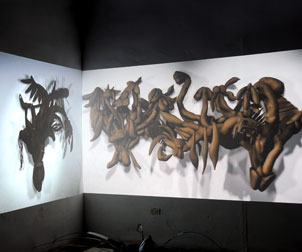Racism in Contemporary Cuba Explored in Mattress Factory Exhibition, Cocurated by Pitt's Alejandro de la Fuente
 "Ceiba Negra, 2010," by Elio Rodriquez
"Ceiba Negra, 2010," by Elio RodriquezFollowing a successful run in Havana, Cuba, the exhibition Queloides/Keloids: Race and Racism in Cuban Contemporary Art is making its way to The Mattress Factory, 500 Sampsonia Way, North Side.
Queloides is cocurated by Alejandro de la Fuente, a University Center for International Studies research professor of history and Latin American Studies, and Cuban artist Elio Rodríguez Valdés. The exhibition will open Oct. 15 and continue through Feb. 27 at the North Side contemporary installation-art museum. Cosponsored by Pitt’s Center for Latin American Studies (CLAS) within the University Center for International Studies (UCIS), the exhibition addresses the debate about the persistence of racism in contemporary Cuba and throughout the world.
While taking steps to eliminate inequality, the Cuban revolution suppressed discussions of race, claiming that discrimination had been forever eliminated from the island. After decades of being considered taboo, discussions about race and racism occur more openly in contemporary Cuba. In the early 1990s, artists, scholars, and writers in Cuba began to do the unthinkable: denounce the persistence of racial discrimination in Cuban socialist society.
“Queloides is the answer of a group of Cuban visual artists and intellectuals to these changing realities,” says de la Fuente. Artists such as the ones showcased in Queloides, he continued, “have tried to articulate an answer to the deteriorating racial situation in Cuba. It is the protest of a generation that grew up in a mostly egalitarian society and that then witnessed how that society collapsed in front of their eyes.
“Since its conception, the exhibition has been a product of collaboration between Cuban artists and intellectuals and American institutions, such as Pitt’s CLAS and the Mattress Factory museum,” adds de la Fuente. “We wanted to bring the exhibit to Pittsburgh because race and racism are not issues unique to Cuba. We hope people here will learn more about Cuba, but we also hope that Cuban artists get a chance to learn more about American society and culture.”
The exhibition displays the work of cocurator Valdés, whose work explores race, gender, nationalism, and globalization, in addition to 11 other artists renowned for their critical work on issues of race, discrimination, and identity.
The Queloides promotional materials help explain the meaning behind the exhibition’s name: “Keloids are wound-induced, pathological scars. Although any wound may result in keloids, many people in Cuba believe that the black skin is particularly susceptible to them. Thus the title evokes the persistence of racial stereotypes, on the one hand, and the traumatic process of dealing with racism, discrimination, and centuries of cultural conflict, on the other hand. Queloides/Keloids includes several art forms—paintings, photographs, installations, sculptures, videos—and offers novel ways to ridicule and to dismantle the so-called racial differences.”
Funders for the exhibition include the Christopher Reynolds Foundation, Inc., the Ford Foundation, the Lambent Foundation, the National Endowment for the Arts, the Pennsylvania Humanities Council, The Pittsburgh Foundation, and Pitt’s Central Research Development Fund, CLAS, UCIS, Humanities Center, World History Center, and the Dean of the School of Arts and Sciences.
On Oct. 14, Pitt will host a roundtable discussion with several of the artists featured in the exhibition. The artists will discuss their participation in Queloides as well as issues of race and culture in contemporary Cuba. The free public discussion will be held from noon to 2 p.m. in 4130 Posvar Hall.
Other Stories From This Issue
On the Freedom Road

Follow a group of Pitt students on the Returning to the Roots of Civil Rights bus tour, a nine-day, 2,300-mile journey crisscrossing five states.
Day 1: The Awakening
Day 2: Deep Impressions
Day 3: Music, Montgomery, and More
Day 4: Looking Back, Looking Forward
Day 5: Learning to Remember
Day 6: The Mountaintop
Day 7: Slavery and Beyond
Day 8: Lessons to Bring Home
Day 9: Final Lessons

